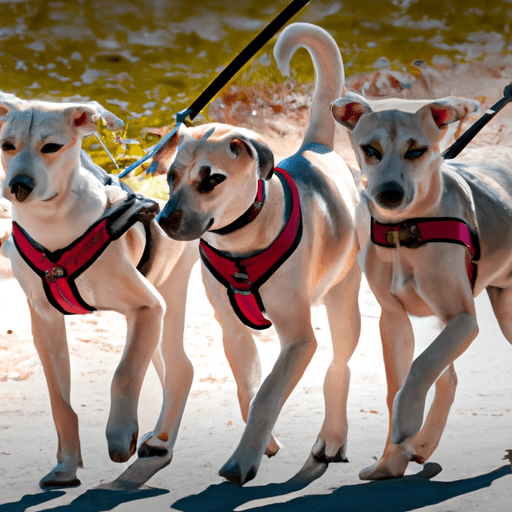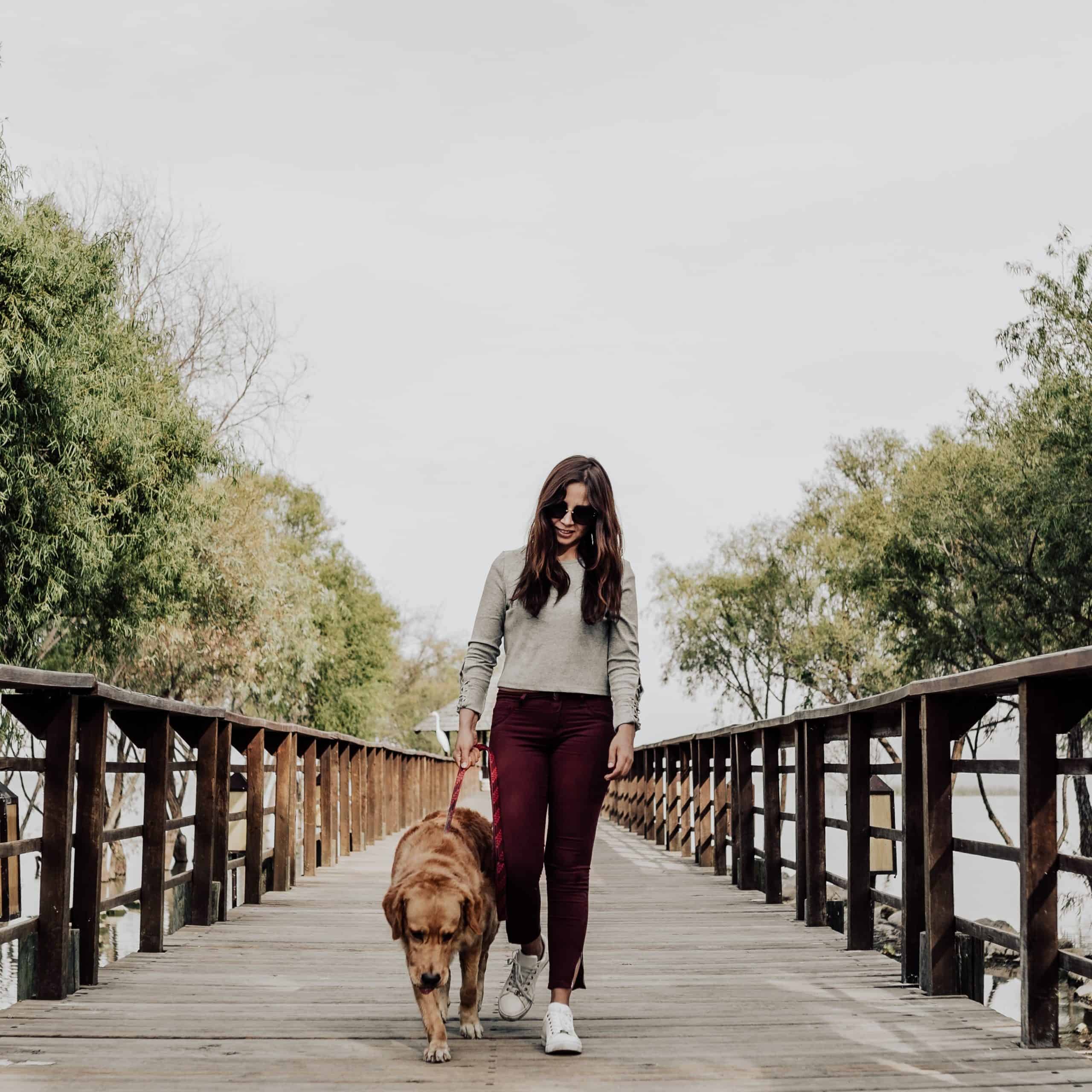Do you ever wonder how often your pup needs to be taken for a walk? Caring for a pet can be incredibly rewarding, but ensuring they stay healthy and happy is no small task. You probably already know plenty of exercise is key to maintaining your dog’s well-being, so how often should you go on those long walks with Fido? This blog post will explore the importance of regular walking for dogs and their owners and how much time you should spend exercising with your furry friend daily.
No matter your beloved pup’s breed, age, or size, regular exercise is vital for its mental and physical health. The frequency with which one walks their canine companion depends on specific needs; some dogs require more stimulating activities than others, while some may be perfectly content with shorter and less frequent walks. Generally speaking; however, adult dogs should have at least a 30-minute walk every day. Younger dogs and senior canines who cannot handle long distances may only need a ten or a 15-minute jaunt around the block.
In addition to providing physical activity, walking any dog breed is also a great way to provide mental stimulation. An energetic canine can quickly become bored and destructive if they do not receive enough of the right kind of exercise. Taking your pup out for daily walks will help them stay mentally sharp, reduce behavior problems, and keep them from becoming restless – all benefits you’ll likely appreciate as much as your pup.

How Often Do You Walk Your Dog? (Key Findings)
Healthy senior dogs with no pre-existing medical issues such as arthritis or obesity may be able to go several days without going out for a walk if they receive ample exercise in other ways, such as playing fetch in the yard or getting additional daily play sessions indoors. That said, skipping out on walks altogether isn’t recommended because it can cause behavioral issues over time due to boredom or lack of outdoor stimulation.
Puppies and older dogs need to go on more walks than other dogs. Puppies need help learning about their new home and surroundings, while seniors can get tired quickly if they move around too much. So it’s better to take them on lots of short walks instead of a few long ones.
Furthermore, obese dogs significantly benefit from regular walking since this form of exercise has been found to help reduce body fat levels and increase muscle mass and cardio capacity, thereby reducing the risk for many preventable diseases like diabetes & hypertension that come with excess weight gain.
- Adult dogs should have at least a 30-minute walk every day.
- Puppies and senior canines may need shorter, 10-15 minute walks.
- Walking your dog is vital for both physical and mental health.
- Regular exercise helps reduce behavior problems and keep your pup from becoming restless.
- It’s also a great way to bond with your pet and spend quality time together.
- Talk to your vet about which type of exercise is best for your pup, and stick to a consistent routine.
By ensuring that your dog gets enough exercise, you can help keep them healthy, happy, and well-behaved for years to come.

What are the benefits of walking my dog for their health?
Taking your canine companion for a walk is an uncomplicated activity that has numerous advantageous results on various aspects of physical fitness, including:
Maintaining a healthy weight and body condition is essential to overall health. To help prevent obesity, which can lead to medical complications, it is necessary to expend more energy than consumed. Regular walks with your pup are an excellent way to burn extra calories and maintain a healthy weight for you and your canine companion.
Maintaining Joint Health is essential for all dogs, especially seniors. Lack of movement can cause stiffness and reduce a dog’s range of motion; hence, it is essential to keep joints active to ensure proper functioning.
Exercising regularly assists in keeping the digestive system functioning properly. Some dogs are accustomed to “eliminating” on a set schedule. Give your dog routine trips outside to protect against irregularity. Every dog needs at least one trip outside each day for exercise and to do their business.
Of course, it is important to consult your veterinarian before embarking on an exercise program.

How Often Do You Need To Walk Your Dog?
Depending on the size and breed of your canine companion, the number of daily walks they need can vary greatly. Miniature and Toy breeds like Dachshunds or Shih Tzus need less movement, with a 15- to 20-minute daily stroll enough to stay in shape. Medium and large-size breeds will require 30 minutes to hour walks each day, while extra-large breeds like Bernese Mountain Dogs, Great Danes, and Akitas are best suited with two 30-minute walks a day.
The frequency at which you need to take your dog out will depend on their age; puppies, in particular, should be walked multiple times a day, as they need frequent breaks. Smaller dogs will also require more frequent walks than large breeds, as they cannot handle prolonged physical and mental activity periods. When taking your pet on a walk, observe their behavior – if they seem overwhelmed or start exhibiting signs of exhaustion, it’s time to head home.
How To Train Dog Walking Beside You (Step-By-Step)
Training a dog to walk beside you is one of the most fundamental things you can teach your pet. The best way to accomplish this is with an investment of patience, a pocket full of treats, and positive reinforcement. Dogs walk faster than us naturally. So getting them to stay close to you might seem difficult at first, but it can be done with practice and dedication. Here’s how:
Step 1: Start in a low-distraction environment – like your backyard or an empty park. This will help keep your pup focused on the task at hand.
Step 2: Position your dog at your side with some slack on the leash.
Step 3: Make sure your pup looks at you, then take a few steps forward. If your dog starts to forge ahead of you, you will move backward one or two steps. If the dog stays at your side, you continue to move forward. Use praise when your dog is in the correct position.
Step 4: Continue this process until your dog has taken five steps alongside you in the desired direction.
Step 5: When your pup is consistently walking by your side, start making turns and repeating this process.
Step 6: Once you’ve mastered the basics, increase the difficulty by adding distractions such as other people or animals.
Step 7: As soon as you feel confident that your pup can stay focused while walking beside you, it’s time to head outside and practice in real-world conditions.
Keep practicing these steps but don’t expect perfection overnight – be patient, as it will eventually click! Soon enough, your pooch will happily walk next to you on any outing!
How To Stop My Dog Barking When Out Walking (5 Tips)
Keeping your pup’s barking under control when out for a walk is essential for many reasons. Walking a barker can be a real challenge and a source of embarrassment.
Fortunately, several easy techniques can help to prevent it.
Try using treats and rewards – when you spot your dog getting ready to bark at something, quickly give them treats or other forms of reward to redirect their focus away from the source of their excitement.
Spend some time working with your dog on walks; teach them things like sit and stay, which will help them remain calm – even in exciting situations.
Avoid any triggers you know make your pup bark by taking alternate routes or avoiding certain parks or stops altogether.

Another critical tip is to provide regular exercise for your canine companion: well-exercised dogs tend to bark less on walks as they are preoccupied with physical exertion activities. Overall, proactively training and modifying behavior through distraction and reward will assist in stopping excessive barking as you enjoy a pleasant and peaceful walk together!
Finally, keep up with your pup’s socialization training – this teaches your dog to interact appropriately with other people and pets they encounter while walking.
Following these five simple steps, you can ensure your pup remains quiet during walks and enjoys their time out exploring the world!
How To Stop Dog From Pulling On Leash When Walking (5 Tips)
1. Start with the basics
Before you train your dog not to pull on the leash, ensure you have all the basic supplies you need. You will need a collar or harness that fits your dog snugly, an appropriate leash, and some tasty treats.
2. Make sure your dog is well-exercised
One of the main reasons that dogs pull on leashes is because they have too much energy. If your dog has a lot of energy, give them plenty of exercises before you go for a walk. A tired dog is much less likely to pull on the leash.
3. Teach your dog to walk calmly by your side
Start by teaching your dog to walk calmly by your side without pulling on the leash. Begin by walking slowly and rewarding your dog for staying by your side. As they get better at it, you can increase the speed of your walk.
4. Be consistent with your commands
When you are training your dog not to pull on the leash, it is essential to be consistent with your commands. If you allow them to pull on the leash sometimes, they will not understand why they are not allowed to do it other times. So, whenever they start to pull, give them a firm “no” and stop walking until they calm down.
5. Be patient, and keep up the good work!
Training a dog not to pull on the leash takes time and patience. But if you are consistent with your commands and rewards, you will eventually see results. So, don’t get discouraged if it takes a little while!
Frequently asked questions
How long can a dog go without a walk?
It is essential to understand that how long a dog can go without a walk depends on various factors, from your dog’s breed to age and health status. Dogs should generally have at least one walk per day for optimal physical and mental health. This activity helps keep them well-exercised, provides valuable socialization opportunities and stimulates their senses.

What happens if you don’t walk your dog?
Not walking your dog can have a negative impact on its physical and mental health. Regular walks can keep them fit, help maintain their ideal body weight, and prevent obesity. Walking is also an excellent way for dogs to get much-needed exercise, mental stimulation, and socialization with other people or pets.
Without regular walks, your dog may become overweight, leading to serious health problems like diabetes or joint pain. Overweight dogs are also more prone to developing cardiovascular disease later in life. An unhealthy diet combined with a lack of activity can quickly cause an animal to become obese; this strains the heart and accelerates the development of chronic illnesses such as arthritis.
Additionally, going without regular walks deprives your pet of valuable opportunities for mental stimulation that positively encourages exploration and learning behavior among some breeds of dogs — especially young puppies who require extra attention to develop social skillsets early in life.
Do dogs get bored walking the same route?
It is natural for humans to get bored of walking the same route over and over, but what about our canine friends? Despite their incredible sense of smell, it is possible for dogs to become tired of walking the same path. While some dogs view walks as an opportunity for exercise, others need mental stimulation through variety and novelty. If your pup seems disinterested in going on his daily walk, try discovering some new routes or introducing different objects or smells along the way – your pup might surprise you with how quickly he adapts and starts enjoying the change of pace!
How do you tire a dog out without walking?
Keeping your dog active and entertained doesn’t have to mean taking long walks; there are plenty of other ways to tire them out that don’t even require leaving the house. Consider teaching them new commands or tricks and rewarding them for completing them – puzzles can help too! A tired and mentally-stimulated pup is a happy pup – it’s one of the reasons why pet owners invest in interactive toys, like treat dispensers or snuffle mats. You can even play hide-and-seek with your pup – make sure you offer plenty of praise when they find what they’re looking for. Your dog will be physically tired and mentally stimulated after playing together. With these ideas, you’ll be able to give your pup the exercise they need while also creating more bonding moments with them!
How Often Do You Have To Walk Your Dog? (Closing Thoughts)
All things considered, no ‘set’ amount of time applies across the board – however, based upon current research into canine wellness, most experts agree that at least 1hr twice daily (preferably outdoors in sunlight) would serve best for all breeds under normal circumstances aside occasional days off here and there; make sure you observe signs including energy level drops/issues sleeping later, etc.
Constantly adjust your routine based on your pet’s needs and preferences. Last but not least, be sure to have a good time together during the process – happy walks!
Recent Posts
As a dog owner, you want to ensure that you take proper care of your furry companion. A common question that many pet owners have is, "Can I walk my dog 30 minutes after eating?" Understanding the...
Have you ever considered getting an elevated dog bed for your furry friend, but wondered if it's worth the investment? If so, you're not alone. As dog owners, we all want to provide the best care for...

